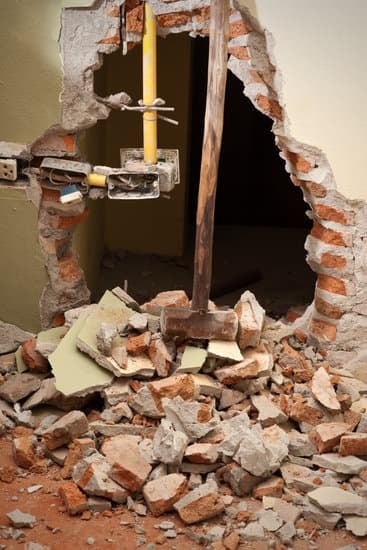When it comes to home improvements, knowing what qualifies for tax purposes can make a significant difference in your financial planning. Understanding the tax benefits available can help homeowners save money while making necessary updates or renovations to their properties.
In this article, we will delve into the topic of home improvements for tax purposes, exploring what is considered a home improvement, qualifying expenses, deductible expenses, non-deductible expenses, required documentation, potential tax credits, and the importance of seeking professional advice.
Home improvements are not only about enhancing the aesthetics and functionality of your living space but also about potentially reducing your taxable income. By familiarizing yourself with what qualifies as a home improvement according to tax authorities, you can ensure that you take advantage of any available tax benefits. Whether you are considering adding new rooms to your house, installing energy-efficient systems, or renovating your kitchen, understanding the criteria for qualifying expenses is crucial.
However, it’s important to note that not all home-related expenditures fall under the category of eligible improvements. Distinguishing between repairs, maintenance tasks, and true home improvements is essential for tax purposes.
While minor repairs and routine upkeep do not typically qualify as deductions or credits on your taxes, certain eligible expenses can result in significant savings. This article aims to provide clarity on this topic by explaining what does and does not qualify as a home improvement for tax purposes.
By gaining insight into which expenses are considered qualifying home improvements for tax purposes, homeowners can strategically plan their projects and allocate their resources more effectively. Moreover, understanding the potential tax deductions available for these types of expenses allows individuals to make informed decisions that maximize their financial benefits. Throughout this article, we will explore various relevant topics such as deductible and non-deductible home improvement expenses and the importance of maintaining proper documentation.
For homeowners who wish to leverage potential tax credits related to their home improvements projects even further, this article also explores different tax credit programs available. Additionally, due to the complexities of tax laws that can vary based on individual circumstances and location, seeking advice from a professional tax consultant or accountant is highly recommended. They can guide homeowners through the intricacies of home improvements for tax purposes to ensure they maximize their benefits within legal boundaries.
Defining Home Improvements for Tax Purposes
When it comes to tax purposes, it is crucial to understand what qualifies as a home improvement. According to tax authorities, a home improvement refers to any project that adds value to your home, prolongs its life, or adapts it for new uses. It is important to note the distinction between repairs, improvements, and maintenance.
Repairs are simple fixes that keep your home in good condition. These include activities such as fixing a leaky pipe, replacing broken windows, or patching up holes in the wall. Repairs are typically not considered as home improvements for tax purposes.
On the other hand, home improvements involve more substantial changes that enhance your property’s overall value or functionality. Examples of home improvements include adding new rooms or extensions, installing energy-efficient systems like solar panels, upgrading the kitchen or bathroom, or renovating the entire house.
Maintaining clear distinctions between repairs, improvements, and maintenance is essential because only certain expenses qualify for tax benefits. While routine maintenance and minor repairs do not usually count towards tax deductions or credits, qualifying home improvements can potentially save you money on your taxes.
For homeowners planning to undertake projects that may be considered as home improvements for tax purposes, it is vital to maintain proper documentation throughout the process. Keep invoices, receipts, and contracts related to the project organized and easily accessible for when you file your taxes. Consult with a tax professional if needed to ensure you accurately categorize your expenses and make informed decisions regarding potential tax benefits.
Qualifying Home Improvement Expenses
When it comes to home improvement expenses, it is important for homeowners to understand what qualifies for tax purposes in order to potentially save money. The Internal Revenue Service (IRS) defines home improvements as those that add value to the property or prolong its useful life. It is crucial to distinguish between repairs, improvements, and maintenance, as only certain expenses are considered qualifying for tax purposes.
So, what expenses can be considered as qualifying home improvements? Here are some examples:
- Adding new rooms or making structural changes: If you decide to add an extra bedroom, a bathroom, or make any other structural changes to your home, these expenses generally qualify as home improvements.
- Installing energy-efficient systems: Upgrading your HVAC system, adding solar panels, or installing energy-efficient windows can all be considered qualifying expenses for tax benefits. These not only improve your home but also contribute to energy conservation.
- Renovating the kitchen or bathroom: Major renovations in these areas of your home also typically qualify as home improvements. This includes replacing cabinets and countertops, upgrading appliances, or redoing plumbing and electrical work.
On the other hand, minor repairs and routine maintenance usually do not qualify as home improvements for tax purposes. Painting walls, fixing a leaky faucet, or replacing broken tiles would generally fall under the category of repairs rather than improvements. It is important to consult with a tax professional if you are uncertain about whether specific expenses qualify.
To maximize potential tax benefits for home improvements, proper documentation is essential. Keep records of invoices, receipts, contracts with contractors or builders involved in the project, and any related financial statements throughout the process. This documentation will serve as evidence when claiming deductions or credits on your tax return.
Tax Deductible Home Improvement Expenses
When it comes to home improvements, one of the most significant benefits for homeowners is the potential for tax deductions. By understanding which expenses qualify as tax deductible, homeowners can take advantage of these deductions to reduce their taxable income and save money. In this section, we will explore the various tax deductions available for home improvements and provide examples of eligible expenses.
Deducting Energy-Efficient Systems
One common category of tax-deductible home improvement expenses is the installation of energy-efficient systems. These systems aim to reduce energy consumption and promote sustainability in homes. Examples of energy-efficient improvements include installing solar panels, geothermal heat pumps, wind turbines, or energy-efficient windows and doors. Homeowners who make these types of upgrades may be eligible for a residential energy-efficient property credit.
The residential energy-efficient property credit allows homeowners to claim a percentage of their qualifying expenses as a credit against their taxes owed. It is important to note that there are specific eligibility requirements and limitations associated with this credit. Consulting a tax professional can help ensure that homeowners accurately identify and claim these deductions when filing their taxes.
Mortgage Interest Deduction
Another significant tax deduction available for home improvements is the mortgage interest deduction. This deduction allows homeowners to deduct the interest they pay on their mortgage from their taxable income. While this deduction primarily applies to mortgage loans used for purchasing or improving a primary residence or second home, it can also include loans taken out for major renovations or additions to an existing home.
To qualify for the mortgage interest deduction, homeowners must itemize their deductions on Schedule A of Form 1040 and meet certain criteria set by the Internal Revenue Service (IRS). It is crucial to maintain proper documentation regarding these expenses, such as invoices or receipts, in order to support any claims made during tax filing.
Non-Tax Deductible Home Improvement Expenses
When it comes to home improvements, it’s important for homeowners to understand that not all expenses will qualify for tax deductions. While some home improvement expenses can provide significant tax benefits, others may not be eligible for deductions. This section will discuss the expenses that do not qualify for tax deductions and provide examples of non-tax deductible home improvement expenses.
In order to determine whether an expense qualifies for a tax deduction, the IRS looks at several criteria. Generally, expenses that are considered personal or aesthetic in nature are unlikely to be eligible for deductions. For example, if you decide to remodel your living room solely to update the design and style without any functional or energy-efficient upgrades, it would likely be considered a non-tax deductible expense.
Similarly, purchases of furniture or other household items are typically not eligible for tax deductions since they are considered personal property rather than improvements to the home itself. However, if these items are part of a larger home improvement project such as renovating a kitchen or bathroom, there may be some opportunities for partial deductions.
Here are some examples of non-tax deductible home improvement expenses:
- Adding personal aesthetic features such as decorative lighting fixtures.
- Purchasing furniture or appliances.
- Landscaping purely for aesthetic purposes.
- Installing swimming pools or hot tubs solely for recreational use.
It is important to review the IRS guidelines and consult with a tax professional to fully understand which expenses may qualify for tax deductions and which do not. By understanding which expenses are non-tax deductible, homeowners can make informed decisions about their home improvement projects and maximize their potential tax benefits.
| Expense Type | Examples |
|---|---|
| Personal Aesthetic Features | Decorative lighting fixtures |
| Personal Property Purchases | Furniture or appliances |
| Purely Aesthetic Landscaping | Landscaping for visual appeal only |
| Recreational Installations | Swimming pools or hot tubs solely for recreational use |
Required Documentation for Tax Purposes
Required documentation plays a crucial role in maximizing tax benefits for home improvements. Without proper documentation, homeowners may miss out on valuable deductions and credits. This section will provide guidelines on the necessary documents to keep for tax purposes, offer tips on organizing and storing these documents, and emphasize the importance of maintaining accurate records.
Documents to Keep
To ensure eligibility for tax benefits, homeowners should keep detailed records of their home improvement expenses. Some essential documents to keep include invoices from contractors or suppliers, receipts for materials and equipment purchased, and contracts or agreements related to the work completed. These documents serve as evidence of the expenses incurred and help support any claims made during tax filing.
Additionally, it is important to have documentation that demonstrates when the work was done. This can include photographs taken before, during, and after the project as well as permits obtained for major renovations or additions. Having a clear timeline helps establish that the improvements were made within the appropriate tax year.
Tips on Organizing and Storing Documents
Organizing and properly storing your home improvement documents can save you time and stress when it comes time to file taxes. Here are some tips to help you stay organized:
- Create a dedicated folder: Designate a specific folder (either physically or digitally) for all your home improvement-related documents. This will help you keep everything in one place.
- Label your documents: Clearly label each document with relevant information like the date, description of work or purchase, and contractor’s contact information if applicable.
- Back up digital files: If you choose to store your documents digitally, make sure you back them up regularly in case of any technical issues.
- Keep an ongoing record: As you undertake different projects throughout the year, make it a habit to consistently update your record with new invoices, receipts, contracts, etc., so nothing is missed.
- Consult with a tax professional: If you’re unsure about which documents to keep or how to organize them effectively, seek guidance from a tax professional. They can provide personalized advice based on your specific situation.
Maintaining accurate and organized documentation ensures that you have the necessary support when claiming tax benefits for your home improvements. By following these guidelines and consulting with a tax professional, homeowners can maximize their potential savings and make informed decisions regarding their projects.
Tax Credits for Home Improvements
When it comes to home improvements, not only can homeowners benefit from tax deductions, but they may also be eligible for tax credits. Unlike deductions that reduce taxable income, tax credits directly reduce the amount of taxes owed. In this section, we will explore some potential tax credit programs available for home improvements.
One popular tax credit program is the Residential Renewable Energy Tax Credit. This program offers a credit of up to 26% of qualified expenses for installing renewable energy systems in homes. Examples of qualifying improvements include solar panels, wind turbines, geothermal heat pumps, and fuel cells. Homeowners can claim this credit when filing their federal taxes and potentially save thousands of dollars while simultaneously investing in sustainable energy solutions.
Another notable tax credit program is the Historic Rehabilitation Tax Credit. This credit is designed to encourage the preservation and rehabilitation of historic buildings by offering a financial incentive.
Property owners who undertake significant renovation work on historic structures may qualify for this credit, which can cover up to 20% of the qualified expenses incurred during the rehabilitation process. It’s important to note that specific criteria must be met to be eligible for this credit, including compliance with preservation standards set by local authorities.
It’s essential for homeowners considering home improvement projects to research and understand the various tax credit programs available at local, state, and federal levels. These programs often have specific requirements and limitations that must be met to qualify for the credits. Consulting with a tax professional or accountant experienced in handling home improvement tax matters can provide valuable guidance on navigating these programs and maximizing potential savings.
| Tax Credit Program | Description |
|---|---|
| Residential Renewable Energy Tax Credit | Aims to incentivize homeowners to install renewable energy systems in their homes by offering a direct reduction in taxes owed based on qualified expenses. |
| Historic Rehabilitation Tax Credit | Encourages the preservation and rehabilitation of historic buildings by providing a credit that covers a percentage of qualified expenses incurred during renovation work. |
Consult a Tax Professional
When it comes to understanding and maximizing tax benefits for home improvements, consulting a tax professional or accountant is highly recommended. The intricacies and complexities of tax laws can vary based on location and individual circumstances, making it essential to seek personalized advice. A tax professional can provide guidance tailored to your specific situation and ensure that you take advantage of all available tax benefits.
One of the main reasons to consult a tax professional is the ever-changing nature of tax laws. Legislation related to home improvement tax benefits can be updated frequently, and it may be challenging for homeowners to stay up-to-date with all the changes. A knowledgeable tax professional will be aware of the latest regulations and how they impact your eligibility for deductions or credits.
Furthermore, every homeowner’s situation is unique, and what works for one person may not apply to another. Factors such as income level, property type, and personal circumstances can influence the tax benefits you are eligible for. By consulting a tax professional, you can receive personalized advice tailored to your specific needs and goals.
In addition to providing expertise in navigating tax laws, a tax professional can also assist in optimizing your overall financial strategy. They can help you determine if it is more advantageous to utilize deductions or credits based on your individual situation. Moreover, they may identify other potential areas where you could save money on taxes that you might not have considered.
Conclusion
In conclusion, understanding what qualifies as a home improvement for tax purposes is essential for homeowners who want to maximize their tax benefits. By distinguishing between repairs, improvements, and maintenance, homeowners can ensure they are accurately categorizing their expenses and taking advantage of potential deductions. It is important to note that minor repairs or routine maintenance typically do not qualify for tax benefits.
Qualified home improvement expenses can include adding new rooms, installing energy-efficient systems, or renovating the kitchen. These expenses can potentially be deducted from taxable income, providing homeowners with significant savings. Examples of eligible tax deductions include the Residential Energy Efficient Property Credit and the Mortgage Interest Deduction.
On the other hand, there are also non-tax deductible home improvement expenses such as personal aesthetic changes or furniture purchases. Homeowners should be aware of these expenses and not expect them to provide any tax benefits.
Proper documentation is crucial when it comes to claiming tax deductions for home improvements. Homeowners should keep track of invoices, receipts, contracts, and any other relevant documents to support their claims. Organizing and storing these documents in an organized manner will make the process smoother come tax season.
Lastly, it is highly recommended that homeowners consult a tax professional or accountant for personalized advice regarding their specific circumstances. Tax laws can vary based on location and individual factors, so seeking guidance from a professional will help homeowners navigate through complex regulations and maximize their tax benefits.
By understanding what qualifies as a home improvement for tax purposes and following the guidelines outlined in this article, homeowners can make informed decisions about their home improvement projects and potentially save money through valuable tax benefits.
Frequently Asked Questions
What home improvements are tax-deductible IRS?
Home improvements that can be tax-deductible according to the IRS include those that are considered medically necessary for individuals with disabilities, such as installing ramps, rails, or other accessibility modifications. These modifications must specifically enable a person with disabilities to function more easily within their home.
Additionally, certain energy-efficient home improvements may also qualify for tax credits, such as installing solar panels or energy-efficient windows and doors. It is important to note that these deductions and credits may have specific criteria and limitations, so it is crucial to consult the IRS guidelines or seek professional advice when considering tax deductions for home improvements.
What home improvements are not tax-deductible?
Not all home improvements are tax-deductible according to the IRS. Generally, any upgrades or renovations made for personal aesthetic purposes or general repairs and maintenance would not qualify for tax deductions.
This includes painting a room, adding new fixtures or appliances, replacing flooring, or repairing a leaky roof. The IRS considers these types of improvements as enhancing the value of your property rather than directly related to medical necessity or energy efficiency.
What is the IRS definition of home improvement?
The IRS defines home improvement as any modification made to a taxpayer’s primary residence that increases its value, prolongs its useful life, adapts it for new uses, or restores it to its original condition. This broad definition encompasses a wide range of renovations and modifications performed on a residential property.
However, it is important to remember that not all home improvements fall under the category of deductible expenses for tax purposes. To qualify for deductions or credits on home improvements, they must meet specific criteria set by the IRS regarding medical necessity or energy efficiency standards outlined in their guidelines and publications.

I’m thrilled to have you here as a part of the Remodeling Top community. This is where my journey as an architect and remodeling enthusiast intersects with your passion for transforming houses into dream homes.





